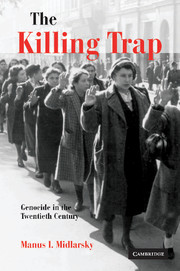Book contents
- Frontmatter
- Contents
- Preface
- PART I Introduction
- PART II Explaining perpetrators: theoretical foundations
- 3 Continuity and validation
- 4 Prologue to theory
- 5 A theoretical framework
- PART III The theory applied
- PART IV Victim vulnerability: explaining magnitude and manner of dying
- PART V Exceptions
- PART VI Conclusion
- References
- Index
3 - Continuity and validation
Published online by Cambridge University Press: 22 September 2009
- Frontmatter
- Contents
- Preface
- PART I Introduction
- PART II Explaining perpetrators: theoretical foundations
- 3 Continuity and validation
- 4 Prologue to theory
- 5 A theoretical framework
- PART III The theory applied
- PART IV Victim vulnerability: explaining magnitude and manner of dying
- PART V Exceptions
- PART VI Conclusion
- References
- Index
Summary
In order to understand the onset of genocide, we must look at moments during which the vulnerability of victims was clearly established, and at the conditions that established vulnerability in the minds of the perpetrators. In this chapter, I first discuss continuity as one such condition. Later, validation – the absence of serious consequences for perpetrators – is presented as a second condition. In succeeding chapters, explanations will be offered for the transition from massacre to genocide.
Continuity, whether through experience or identification with the mindset associated with mass murder, is supplemented by validation. Validation occurs when a morally reprehensible act, even a heinous act, goes unpunished. If the perpetrators of previous murders were not punished, then to all intents and purposes, in a purely pragmatic sense, the killings were justified by their tacit acceptance.
Continuity of the killing in the three cases
By continuity, I mean prior experience with massacre or identification with the aims and mindset of those associated with mass murder. Genocide as a thoroughgoing eradication requires preparation. And it is not only preparation in the material sense of building gas chambers or buying large numbers of guns and machetes. It is the experience of massacre that is crucial. To be sure, this is not a historical awareness as in Hitler's reference to the genocide of the Armenians in his speech to army commanders prior to the invasion of Poland. Nor does this experience require the perpetrators of genocide themselves to have murdered in the past.
- Type
- Chapter
- Information
- The Killing TrapGenocide in the Twentieth Century, pp. 43 - 63Publisher: Cambridge University PressPrint publication year: 2005



